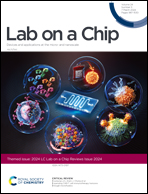AI-enhanced biomedical micro/nanorobots in microfluidics
Abstract
Human beings encompass sophisticated microcirculation and microenvironments, incorporating a broad spectrum of microfluidic systems that adopt fundamental roles in orchestrating physiological mechanisms. In vitro recapitulation of human microenvironments based on lab-on-a-chip technology represents a critical paradigm to better understand the intricate mechanisms. Moreover, the advent of micro/nanorobotics provides brand new perspectives and dynamic tools for elucidating the complex process in microfluidics. Currently, artificial intelligence (AI) has endowed micro/nanorobots (MNRs) with unprecedented benefits, such as material synthesis, optimal design, fabrication, and swarm behavior. Using advanced AI algorithms, the motion control, environment perception, and swarm intelligence of MNRs in microfluidics are significantly enhanced. This emerging interdisciplinary research trend holds great potential to propel biomedical research to the forefront and make valuable contributions to human health. Herein, we initially introduce the AI algorithms integral to the development of MNRs. We briefly revisit the components, designs, and fabrication techniques adopted by robots in microfluidics with an emphasis on the application of AI. Then, we review the latest research pertinent to AI-enhanced MNRs, focusing on their motion control, sensing abilities, and intricate collective behavior in microfluidics. Furthermore, we spotlight biomedical domains that are already witnessing or will undergo game-changing evolution based on AI-enhanced MNRs. Finally, we identify the current challenges that hinder the practical use of the pioneering interdisciplinary technology.

- This article is part of the themed collection: Lab on a Chip Review Articles 2024


 Please wait while we load your content...
Please wait while we load your content...